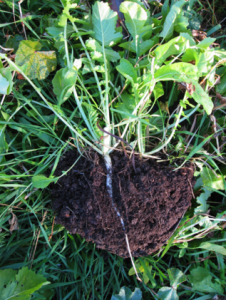More than just dirt, our soils are alive. Healthy soil ecosystems, like ones found in nature, are dynamic and complex. Plants, microbes and fungi work together to cycle nutrients, filter water, and regulate the climate. When treated correctly and allowed to function properly, soils can do wonders for the productivity of a farm and the quality of food it produces, and Vermont farmers are starting to take notice.
At the 5th annual Vermont Farm to Plate Gathering, farmers, community members and scientists came together to discuss the inseparable link between healthy soils, clean water, and good food. Success stories of higher yields from no-till fields and saving money from using less pesticides and herbicides were shared, showing that paying attention to soil health pays off. Though some soil conservation practices may go against conventional techniques, one thing is clear: the healthiest and most successful farms are taking care of their soils by farming like nature.
Plant and soil are one and need each other to function properly.
Nature’s time-tested processes have allowed organisms to survive on this planet for billions of years. It’s time for us to use these processes to our advantage, an idea known “biomimicry”. In the natural world, forests and prairies flourish without pesticides or plows. Trees and plants remain year-round, their leaves nourish the soil in the fall and their roots hold water and soil in place when it rains. Come springtime, these ecosystems are teeming with growth and life. Nature knows how to farm.
Key-note speaker Ray “The Soils Guy” Archuleta spoke passionately and urgently about farming like nature. (Hear Ray on Across the Fence.) According to Ray, “healthy soil is covered all year round,” just like in nature. Cover crops are the most essential component of restoring and maintaining soil health. Plant and soil are one and need each other to function properly. Plants keep the soil cool and moist, and retain soil structure with their roots. Plants take energy from the sun and feed the microbes, which in exchange pull more nutrients from the soil to the plant. Allowing these natural processes to occur significantly decreases the need to purchase and apply additional chemicals and fertilizers that may runoff and damage local waterways during heavy precipitation events.
Healthy soil is covered all year round – just like in nature.
When soil is kept in place and macropores are allowed to form, water quality impacts from agricultural runoff and sedimentation are greatly reduced. Soils also play a large role in regulating carbon. Tilling breaks apart the link between plant and soil, releasing carbon into the atmosphere and depriving microorganisms of their food. Soils become starved, and fail to function properly. But when covered with detritus and plants, soils sequester that carbon and use it for growth instead.
When Ray Archuleta visits a farm, the first thing he looks for is how the soil in the field compares to soil in the forest. If the soils are healthy, a shovel-full from each should look the same, with a layer of detritus, or organic matter, on top, and soil aggregates clinging to the roots of plants on the bottom.
Is your soil bare or covered? Learn more about the secrets in the soil by watching the videos on Ray’s Soil Health Page.
Contributor: Michelle Graziosi, the ECO AmeriCorps Water Quality Research Technician at UVM Extension’s Center for Sustainable Agriculture, attended her first Vermont Farm to Plate gathering. Michelle graduated from the University of North Carolina at Chapel Hill in May with a B.S. in Environmental Sciences.
« Cover crops keep carbon and cash where it belongs Seasoned farmer Andy Jones talks about the seasons at Intervale Community Farm and how he stays ahead of the weather »


Wow! This is a good read. Thanks! May more and more people be aware about this so that nature will be more healthy.